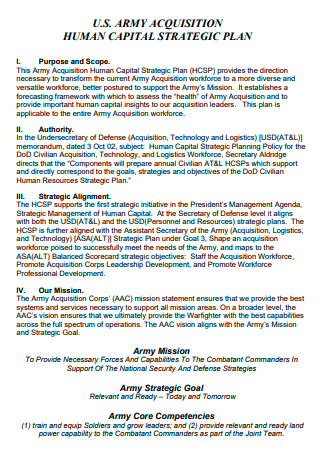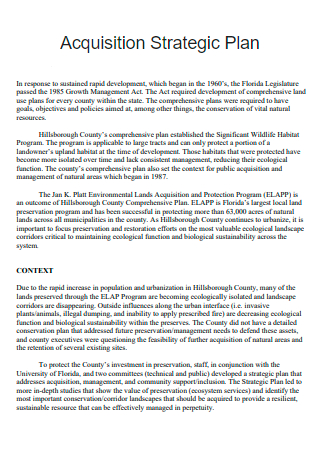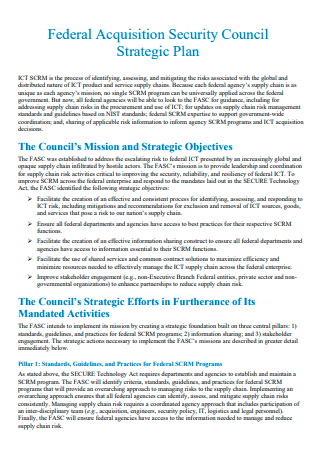3+ Sample Acquisition Strategic Plan
FREE Acquisition Strategic Plan s to Download
3+ Sample Acquisition Strategic Plan
What is an Acquisition Strategic Plan?
Different Types of Acquisition Strategies
Basic Components of an Acquisition Strategic Plan
How to Write an Acquisition Strategic Plan
FAQs
What are the basic components of an acquisition strategic plan?
What are the differences between mergers and acquisitions?
What is an acquisition strategy statement?
What are the key components of a strong merger and acquisition?
What is an Acquisition Strategic Plan?
An acquisition strategic plan is a clear and well-structured roadmap which records all business, cost, schedule, technical, and other considerations which will guide business owners and executives in formulating proper acquisition decisions linked to the investment. This strategic plan is a useful management tool with the purpose of development and success of an acquisition strategy, allowing the identification of risks and consideration of tradeoffs which are essential to mitigate those risks. This plan focuses on driving traffic, conversion, nurturing and sales through advertisement, social media marketing and SEO, lead generation, lead management, lead nurturing tactics, and sales force automation.
One example of acquisition is when Warren Buffett, a famous investor, acquired along with the financial investor 3G Capital the H. J. Heinz Company for $28 billion, becoming the largest transaction in the food industry. The company’s stock price rose more than 20% after the publication of the acquisition or takeover announcement. However, a recent article published by the Harvard Business Review put the failure rate of mergers and acquisition deals between 70% and 90%. Thus, all kinds of business owners, company executives, project supervisors, and many other professionals involved in mergers and acquisitions should effectively create a compelling and well-detailed acquisition strategic plan in order to improve their M&A management processes by enhancing due diligence, encouraging effective communication, strengthening investor management, upgrading inorganic growth strategy, and improving collaboration.
Different Types of Acquisition Strategies
Gunter K. Stahl and Mark E. Mendenhall wrote in Mergers and Acquisitions: Managing Culture and Human Resources that trust building is a central element in the success or failure of M&A. Just as trust within organizations enhances relationships, improves performance, and decreases negative manifestations within these organizational dimensions, trust is also of critical importance to fortifying relationships between organizations in an M&A context. Also, you should be well-informed about the different types of acquisition strategic plans that you will use for your business or organization matters. Here we will explain to you about the different types of acquisition strategies below based on the article written by Marc Goedhart, Tim Koller and David Wessels of McKinsey:
1. Improving the Performance of the Target Company
One of the most common value-creating acquisition strategies is improving the target company’s performance. This simply means when a business owner or CEO buys a company, he or she radically reduces costs to improve margins and cash flows. Some cases show that the acquirer may also take steps to accelerate revenue growth. Private-equity firms usually pursue this type of acquisition strategy. A 2010 report shows that operating-profit margins had an increase of about 1.5% points on average more than those at peer companies during the same period among successful private-equity acquisitions in which a target company was bought, improved, and sold. Business owners and CEOs need to consider that it is easier to improve the company’s performance with low margins and low returns on invested capital (ROIC) than that of a high-margin, high-ROIC company. For example, consider a target company with a 6% operating-profit margin. In order to make a 50% increase in the company’s value, you need to reduce costs by 3%, to 91% of revenues, from 94% increase the margin to 9%.
2. Consolidating to Remove Excess Capacity from Industry
Excess capacities are developed when industries mature. The combination of higher production from current capacity and new capacity from new entrants often produces more supply than demand. Some companies find it easier to shut other brands or product lines across the larger combined entity which results from an acquisition than to shut their least productive brands, product lines or services, without one ending up with a smaller business firm. For instance, the consolidation in the pharmaceutical industry has significantly reduced the capacity of the sales force as the product portfolios of merged companies change and they reconsider how to maintain interaction with doctors and other medical professionals. This means the removal of excess capacity provides a substantial value as the bulk of the value often accumulates to the shareholders of the seller, not the buyer’s.
3. Getting Skills or Technologies Faster or at Lower Cost
Do you want to enhance your own tech products? There are many technology-based companies that buy other companies which have sophisticated technologies they need to level up their own products. Doing this will allow them to acquire the technology more quickly than developing it themselves, as well as avoiding royalty payments on patented technologies, and holding the technology away from their competitors. For example, Apple purchased Beat Electronics, which launched a music-streaming service. The acquisition was made in order to quickly provide a music-streaming service for its customers while the market was going away from Apple’s iTunes business model of purchasing and downloading music.
4. Selecting Potentials Early and Helping Them in Business Development
Business owners and CEOs need to be observant around their fields and industries and make acquisitions early in the life cycle of a new industry or product line, long before the majority of companies recognize that it will grow immensely. Executives and business acquisition strategists need to have a disciplined approach as they need to show their willingness to make investments early, long before the competitors and the market see the company’s potential. They also need to make multiple bets and to anticipate that some will fail. Plus, they need to have the right skills and patience while nurturing the acquired business firms.
Basic Components of an Acquisition Strategic Plan
In this section, you will learn how to construct a well-written and systematic acquisition strategic plan. However, an acquisition strategic plan has different kinds of components. Include the following elements for you to create a professional piece of writing:
How to Write an Acquisition Strategic Plan
Based on the book Mergers & Acquisitions Integration Handbook, acquisitions are integral when companies seek economies of scale, efficiency, and enhanced market visibility, and they are often made as part of a company’s growth strategy. This means it is more beneficial to take over or acquire the operations and niche of an existing firm compared to expanding on its own. Acquisitions are paid for with cash, stock, or a combination of the two and they differ in terms of the necessary level of integration support. Below are some easy-to-follow tips that indicate how to write a clear and structured acquisition strategic business action plan:
Step 1: Define the Needs, Conditions, and Other Aspects of the Acquisition
Write a brief and clear statement of the needs of the acquisition while summarizing the technical and contractual history of the acquisition. Elaborate feasible acquisition alternatives, the effect or prior acquisitions on those alternatives, and any connected in-house effort. Mention all essential conditions affecting the acquisition which includes compatibility requirements with present or future systems or programs, and cost, schedule and capability or performance constraints. Set the established cost goals for the acquisition and the rationale supporting them.
Step 2: Describe the Business Performance
Next, specify the performance characteristics of the business or the performance standards of the services being acquired and state how they are connected to the need. Then, explain the basis for establishing delivery or performance-period requirements. Provide reasons for any urgency if the acquisitions result in concurrency of development and production or create justification for not providing for full and open competition.
Step 3: Discuss Trade-Offs and Risks
Talk about the anticipated consequences of trade-offs among the various cost, capability or performance, and schedule goals. Also, inform them about the technical, cost, and schedule risks while indicating what efforts are planned or underway to minimize risk and the consequences of failure to attain goals.
Step 4: Create a Summary of Background and Objectives
While creating a summary of acquisition background and objectives, you must describe how the competition will be sought, promoted, and sustained throughout the course of the acquisition. Then, discuss the source-selection methods and procedures for the acquisition. Talk about different types of acquisition considerations like multiyear contracting or other special contracting methods. Include the budget estimates, and explain how they were calculated and discuss the schedule of the acquisition.
Step 5: Proofread and Prepare the Overall Plan
Review your entire acquisition strategic plan and make sure that you fully present all the main points in your plan. It should demonstrate the connection between the acquisition strategic planning goals, objectives, resources, strategies and methods, activities used for attaining the objectives, and the evaluation of the people involved in the strategic plan. If you realize that you overlook some sections that need more components, it is essential to edit and revise the document as soon as possible.
FAQs
What are the basic components of an acquisition strategic plan?
The basic components that should be included in an acquisition strategic plan are acquisition strategy overview or executive summary, target description, market overview, sales and marketing details, financial history and projections, transition plan, deal structure, and appendices/supporting documents.
What are the differences between mergers and acquisitions?
Mergers require both businesses to negotiate well as two businesses of similar size and scale of operations combine into one new company. The newly merged companies must form a new entity, name, ownership, and management structures. A merger is a mutual decision between businesses. When you merge with another company, you retain ownership while having a new name and structure. On the other hand, acquisitions happen when one company buys another small business firm. As the business owner of the acquired company, you give up ownership of your business.
What is an acquisition strategy statement?
An acquisition strategy statement is a statement which defines and explains the acquisition approach made by the program management. It is important for the acquirer and the acquired company to help them manage potential program risks and meet program objectives.
What are the key components of a strong merger and acquisition?
To achieve strong merger and acquisition, there are key components that businesses need to establish, practice and execute well. These are communication, win-win, shared vision or new identity, clear plan, and integration. Communication is a crucial key to ensure your merger or acquisition goes smoothly and is the perfect move for both companies. Be clear and straightforward about what you want and expect, and strengthen your new relationship on a foundation of complete honesty. Both sides of the business transaction need to be improving their situation in some way. Set with your business counterparts in the target company what your upcoming combined business’ new identity will be. Clearly plan out many of the crucial details of the transition. Then, organize an integration team fully dedicated to executing and implementing the merger.
The main purpose of acquisition is to improve the performance of the company while elevating the key aspects of one another. An acquisition strategic plan is a well-integrated and coordinated management tool with the purpose of communicating effective acquisition strategies to the corporate leaders and executives of the organization so that they are able to assess acquisition issues and improve their business acquisition. To assist you in acquisition strategic planning, you can learn and apply the tips aforementioned in this article. Plus, we have included several acquisition strategic plan samples that you can download such as army acquisition human capital strategic plan templates, acquisition workforce strategic plan templates, printable acquisition strategic plan examples, and federal acquisition security council strategic plan templates.




